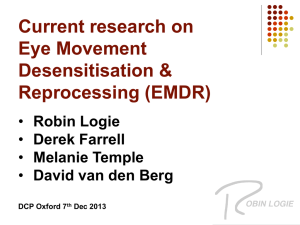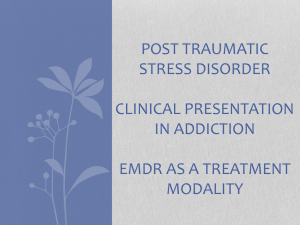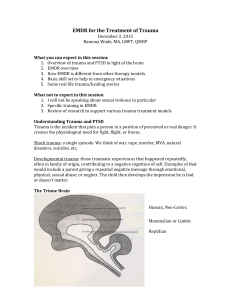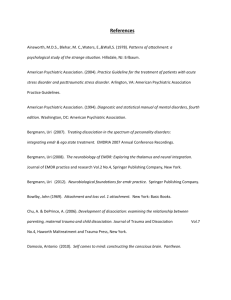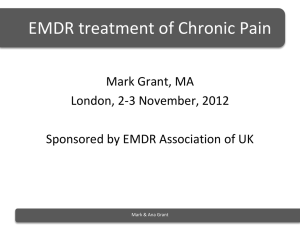Treatment for Military Sexual Trauma
advertisement
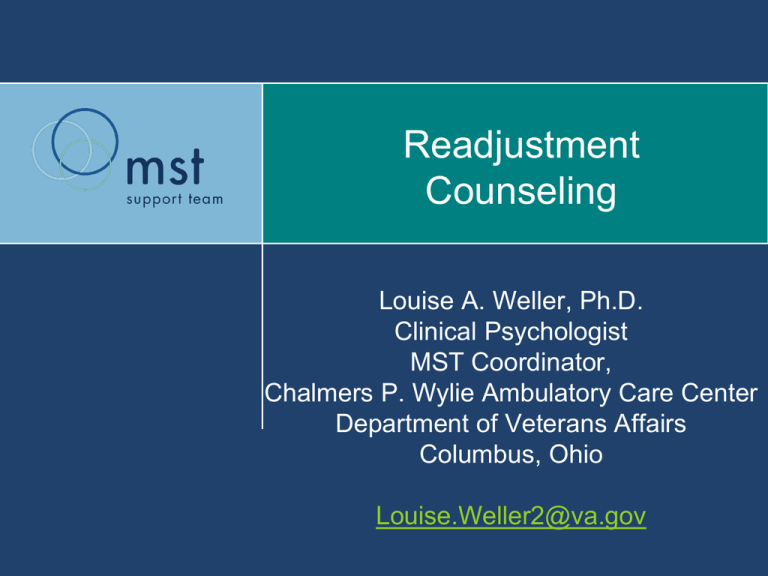
Readjustment Counseling Louise A. Weller, Ph.D. Clinical Psychologist MST Coordinator, Chalmers P. Wylie Ambulatory Care Center Department of Veterans Affairs Columbus, Ohio Louise.Weller2@va.gov Readjustment Issues • • • • • • OEF/OIF veterans will present with subclinical PTSD symptoms. Criteria arousal symptoms prevalent Report hypervigilance and hyperarousal May/may not have reexperiencing or avoidance issues. May/may not have sleep issues Often have some problems with irritability Readjustment Issues • Coming home from a war zone is great and it should be a happy time. But it is not always easy to make the transition home. Veterans except to take up their lives as they left them. They expect to be happy to be home. They look forward to old hobbies, habits, interests and being with family and friends. They may have been told but they often don’t realize what it will mean to readjust for the war zone to the cilivian life. Readjustment Issues • • Being away: life has moved on, other people pick up responsibilities, make new friends, develop new patterns. Dealing with this may cause stress, but usually it is worked out. Being in a war zone: To survive and function, veteran may have acquired skills that were necessary and are behaviorally powerful, but no longer fit in a civilian setting. And they don’t just come off with the uniform. Readjustment Issues • In a war zone” • • • • • • Critically important to be hypervigilant SM carried a weapon much of the time Keep senses on high alert to respond to an emergency quickly and correctly Take charge of situations and order others around as needed SM needs to doubt, question, verify in order to be safe Difficult to relax, to sleep Readjustment Issues • • • Being in extremely intense situations: Events can occur in war zones that have a powerful effect on a veteran’s beliefs about the nature of the world and mankind. War zone skills are over-learned for safety of self and others. What is crucially important is to realize that the rules of the war zone do not automatically change when soldiers come home. Readjustment Issues • • Dr. James Munroe of the Boston VA developed a program for “Transitioning from the War Zone: Information for Veterans and Those Who Care.” It provides information for the veteran and the family about the difficulties of readjusting from life in a war zone, life in a tightly bonded military unit, back to home, family and the civilian life. Readjustment Issues • • • It provides modules with questions that the veteran can work on at home and bring to the next session. It focuses on areas of readjustment such as feeling safe, building trust, dealing with anger, and others. You can google “Transitioning from the War Zone” and find the entire handout. You can email james.munroe@va.gov Treatment for Military Sexual Trauma Louise A. Weller, Ph.D. Clinical Psychologist MST Coordinator, Chalmers P. Wylie Ambulatory Care Center Department of Veterans Affairs Columbus, Ohio Louise.Weller2@va.gov So What Do We Do? An Overarching Framework for Treatment • Judith Lewis Herman’s Trauma and Recovery: The fundamental stages of recovery are… 1. Establishing safety 2. Remembering and mourning 3. Reconnection and meaning-making • Not necessarily a linear progression through these stages • Parallels common distinction between skillsbuilding (stabilization) and trauma processing (exposure) work How? • Plain old good clinical skills: Research has demonstrated the importance of non-specific factors common to all forms of therapy • • • • Forming a therapeutic alliance Demonstrating cultural competence Using systematic case formulation Monitoring patient progress and adjusting practices accordingly Effectively attending to these common factors constitutes evidence-based practice • Empirically-supported treatment protocols: Can be a useful supplement to your work (“new tools for your toolboxes”) A Loose Categorization of Some Commonly Used Protocols Establish safety Seeking Safety Dialectical Behavior Therapy (DBT) Cognitive Processing Therapy (CPT) Prolonged Exposure (PE) Acceptance & Commitment Therapy (ACT) Remember and mourn Reconnect and make meaning Across Stages, Across Treatment Approaches… Top 10 Things I’ve Found Helpful (in no particular order) 1. Adopt a strengths-based approach • Likely a novel, validating idea for the veteran; will help you maintain an empathic, patient stance 2. Empathy goes a long, long way 3. Provide ongoing psychoeducation / normalization / validation 4. Be transparent and genuine 5. Offer choice, restore control 6. Help the veteran balance the big and little picture, the long- and short-term perspective • Hold the hope Across Stages, Across Treatment Approaches… Top 10 Things I’ve Found Helpful (cont.) 7. Figure out what need is being met by a behavior • Engage in a discussion of the pros and cons of meeting it in this way versus some other way 8. Don’t assume you know what the worst part of the 9. veteran’s experience was (and is) Attend to parallel process and other dynamics in the room • Be present, be a witness, and be a secure base 10.Prioritize self-care, so that you can remain engaged • • • Monitor your own reactions Remind yourself that recovery can be a long-term process Seek out support from others Seeking Safety • • • • Developed by Lisa Najavits for concurrent treatment of dually diagnosed individuals with a substance abuse disorder and PTSD. A 25-session manualized treatment that provides a focus every other session on the basics of treating SA and treating PTSD. Provides safety skills training Provides coping strategies. Dialectical Behavior Therapy (DBT) • Some individuals with a history of complex trauma may present for therapy who are not able to engage in psychotherapy due to: • • • • • • Low tolerance for distress Emotional dysregulation Poorly developed behavioral management Chronic suicidality Interpersonal ineffectiveness May engage in self-injurious behavior or chronic substance abuse Dialectical Behavior Therapy (DBT) • • • DBT was developed by Marsha Linehan to treat individuals with complex trauma, particularly those with BPD and suicidality. DBT developed to engage patient in a combination of group therapy, skills coaching counseling, and individual psychotherapy. DBT has been modified to use in private practice and individual clinical settings. Dialectical Behavior Therapy (DBT) • Central aim of DBT: to replace ineffective, maladaptive, or unskilled behavior with skillful responses. Steps to skill building: • • • • acceptance of self identification of maladaptive behavior Develop skills to improve distress tolerance, manage emotional responses, change behavior, identify and regulate cognitions Develop mindfulness skills/wise mind Exposure Therapy • Research has indicated that exposure therapy is an effective treatment for the effects of sexual trauma. • • Foa & Rothbaum, 1998 Research has indicated that Cognitive Behavioral Therapy is an effective treatment for the effects of sexual trauma. • Williams & Poijula, 2005 Exposure Therapy • • • Primary therapy protocols presented are CBT exposure based therapies. Patients who manage to construct a coherent narrative of the trauma event during exposure therapy profit most from treatment. • Foa, 1995 CBT provides a framework to the patient in order to manage affect, probe more deeply, reframe cognitive distortions, and develop more effective coping strategies. • Shipherd, Street & Resick, 2006 Exposure Therapy • • • • • Evidence based therapies that utilize exposure therapy and CBT include: Cognitive Processing Therapy • With and without an exposure element Prolonged Exposure Therapy EMDR Narrative Exposure Therapy Eye Movement Desensitization & Reprocessing (EMDR) • • • An exposure-based therapy that is only taught in certified EMDR training programs. EMDR therapy proposes to directly affect the brain, allowing the individual to resume normal functioning while no longer reliving the images, sounds, and feelings associated with the trauma Most often accomplished by use of eye movements, rhythmic tapping, or sounds. Eye Movement Desensitization & Reprocessing (EMDR) • • • • • • History and treatment planning Education and Preparation EMDR Process: A target - the visual image of a traumatic memory and the associated emotions and bodily sensations. A negative belief about yourself related to the memory, which you will rate depending on how true you feel this belief to be A preferred positive belief about yourself. Eye Movement Desensitization & Reprocessing (EMDR) • • • Reprocessing and Desensitization - the therapist asks the client to hold the image and negative beliefs in mind while EM’s or other rhythmic processes are utilized to initiate/continue dual processing. Installation – the therapist asks the client what s/he would prefer to believe when this image or memory is brought to mind. EMDR proposes that new beliefs about the self and interpretations of the trauma replace old beliefs. Eye Movement Desensitization & Reprocessing (EMDR) • Benefits include: • • • • EMDR does not require the client to go into detail about the distressing events of the past There is no need to analyze the trauma for long periods of time It is client-centered in that the client sets the agenda for the session material Multi-faceted approach – works on mind, body and emotions together. Emotional pain can manifest itself as physical pain and by changing beliefs, experience of pain can be changed. Eye Movement Desensitization & Reprocessing (EMDR) • Concerns include: • • • Training is private and can be quite costly Some patients are uncomfortable with using eye movements or any of the EMDR devices, or with the nearness of the therapist when the eye movements are used. Critics claim that the improvements that have been documented, in dozens of professional journals, are due to the included elements of exposure therapy and CBT process. Narrative Exposure Therapy (NET) • • • • In 3rd World settings, trauma victims are often illiterate, in poverty, and cannot attend long term traditional psychotherapy. Victims are unable to tell what happened to find their own healing or to implicate the perpetrators. NET developed for work in such locations to enable a short-term exposure therapy. Remembering & telling the truth about terrible events are prerequisites for both the restoration of the social order and for the healing of individual victims. • J. L. Herman (1992) Narrative Exposure Therapy (NET) • • • • Victims of trauma may experience “flashes” of memory that activate the fear structure, leading to avoidance of the memory. Victims learn to avoid cues that remind them of the trauma and PTSD is deepened. NET guides the individual through a chronological retelling of the event in the session with the therapist. The therapist writes the story as narrated by the individual. Narrative Exposure Therapy (NET) • • • Initially the therapist establishes the bond with the individual and provides education about the process / rationale for NET. The level of fear may be initially high as the therapist encourages activation of the painful memoires. Prevention of avoidance is inhibited during the session. Habituation of the emotional response occurs as the memories are no longer capable of eliciting the response part of the fear network. Narrative Exposure Therapy (NET) • • NET weaves hot implicit memories as the story unfolds with cool declarative memories, allowing the individual to undergo habituation of the emotional response to the traumatic memory, leading to remission of anxiety. At subsequent sessions, the therapist reads the account, encourages the fear activation with additions/changes to the narrative, within the framework of cognitive behavioral therapeutic challenges. Narrative Exposure Therapy (NET) • • • • • NET is helpful with patients who cannot do exposure therapy work at home or who have problems completing assignments alone. NET is a useful tool with individuals who have not been able to emotionally regulate their fear activation responses. NET would be a useful too for trauma work with children. The manual was written by: Schauer, Neuner, & Elbert, 2005 Adjunctive Therapies: Nightmare Resolution Therapy • • • • NRT designed to help patients who have recurrent nightmares with the same content or the same themes. Protocol is 6-7 sessions, group or individual Treatment focus is on reducing nightmare frequency and intensity. Patient is taught relaxation techniques and sleep hygiene principles Adjunctive Therapies: Nightmare Resolution Therapy • • • First session provides education, with homework to use sleep logs and dream logs, and a target nightmare be identified. Second session , complete target nightmare negative self-beliefs. Continue with logs. HW is to write a changed dream. Third session, modify, as needed, the changed dream and complete changed dream positive self-beliefs . Adjunctive Therapies: Nightmare Resolution Therapy • • • • Patient is instructed to utilize relaxation strategies in combination with reading the changed dream & beliefs three times everyday. Session 4-6, check in with progress, modify dream if needed, check logs. As incidence of target nightmare decreases, the focus of therapy may move to another repititious nightmare. Some individuals stop the dream within the first week, others modify it, but it almost always either decreases or changes. Adjunctive Therapies: Stress / Anger Management • • Therapy that targets problems with managing stress or anger managements can be done in individual or group sessions. Stress M provides education about stress, teaches breathing skills, PMR, imagery rehearsal, body scans, SIT, and mindfulness. SM addresses how to use coping strategies, identifies healthier habits, how to use positive distractions and positive self-talk. Adjunctive Therapies: Stress / Anger Management • • Anger Management incorporates the stress management skills and also focuses on education about anger, how to identify when a person is becoming angry, and strategies to moderate angry responses. Both stress management skills training and anger management skills training are ideal for group settings. Adjunctive Therapies: Sleep Hygiene • • • Primary presenting symptoms for trauma survivors, combat or non-combat, is problems with falling asleep and staying asleep. Sleep Hygiene combines a stress management approach with specific focus on sleep hygiene and strategies. It utilizes a CBT approach to sleep improvement with the use of sleep logs. Treatment for MST-related MH Issues • • • • Basic good clinical skills of developing a therapeutic bond and providing warmth, empathy, and acceptance are key. Improving your own professionalism so that working with these difficult topics is less stressful for your patients. Use peer supervision and be mindful of vicarious traumatization. Training, skills, manuals are available by the internet, through workshops, and from the professional conferences. Treatment for MST-related MH Issues • Thank you for caring about our veterans! • Louise.Weller2@va.gov

